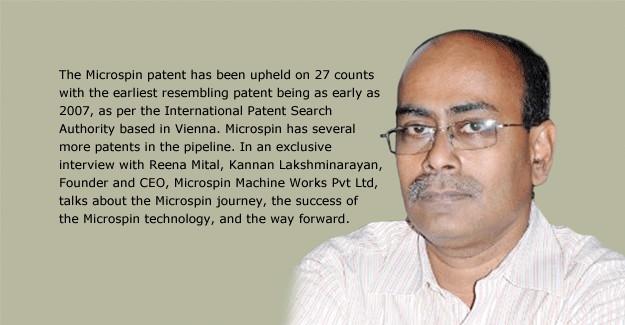
India: To My Surprise, Organised Spinners Have Invested In Microspin Machines, Using It Much More Creatively, Producing Very Different Yarns
Tell us about the Microspin story. How and when did you start this venture?
The first pilot unit of Microspin was commissioned about 20 months ago, with a co-operative in Vidarbha. The idea was to enable the agricultural community to add value to cotton rather than sell the raw produce. We have three installations now - two in Vidarbha and one in Karnataka.
How would you compare the quality of the yarn to that made on the high end conventional European brand machines. What is the level of technology that you offer?
There is no linear scale to measure `quality. There are different facets to quality and their relative importance depends on the end-products the yarn is used for. We produce a premium textured yarn that people compare with linen, silk-noil, etc. It is sought after for end-uses in the apparel and home furnishing segments.
Investment in a Microspin machine is to the tune of Rs 2 crore. How are farmers able to afford this level of investment? Is the TUFS available to them?
Farmers don't invest, small entrepreneurs and professionals-turned-entrepreneurs do. The enterprises in turn employ people from the farming community, whom we train for different job-roles. The earnings of the producers participating in the value-addition go up three-fold, compared to what they would earn if they just sold the primary agricultural produce. However, the investment and the business risks - and hence the profits - belong to the entrepreneur. No, our machines are not covered under TUFS. Accessing any form of government support is too tedious and distracts us from focusing on the core value that we are trying to create for the stakeholders.
Do these units also invest in weaving and garmenting? Where is the market for this fabric or apparel?
The scale of our spinning unit is tens of times smaller than a conventional mill. Therefore it is amenable for forward integration with weaving and garmenting. Our entrepreneurs generally do this in a phased manner, progressively moving up the value-chain. Our customers are various leading brands - domestic and international, buying houses, boutiques, garment exporters, etc. More recently, we have cracked a few product categories that we are supplying at scale to the highly price-sensitive 'unorganised' segment too.
How do the logistics work out for units in Vidarbha?
Being located close to cotton growers enables the unit to buy directly from farmers. Employing local people who otherwise don't have alternate employment options means that attrition is low (the general textile industry is plagued by almost 30% attrition per month!). Co-locating different steps of the value chain reduces transaction costs and turnaround time. Only the end-product is then delivered to the market.
Do you plan to target the organised sector too for the Microspin machine?
I didn't "plan" to, because I didn't think they would be interested. To my surprise, many are now approaching us for the machines; and we have delivered to some of them. And I find that my customers from this segment are using my machines much more creatively, producing yarns very different from what we ourselves do! Clearly, making a machine is like making a violin or a piano -- but it takes a different skill-set to produce the best music.
Are you planning to launch more machines, and your plans to upgrade the technology?
We paused on launching more machines, to focus on expanding the market for the textiles that would be made. We are now seeing a strong pull and we should soon be expanding the production base. Upgrading the technology is a continuous process that would never end. Apart from spinning, we are also doing a lot of innovation in adjacent areas like dyeing, warping, etc. to introduce new product categories into the market. For instance, we recently launched denims and that has been received spectacularly in the market. We are also developing IoT (Internet of Things) and apps enabled solutions to deliver management-as-a-service across multiple dispersed units - this will drastically cut down overhead costs, which are typically high for small units.
Tell us about your plans to move to more regions in the country. How is the government, or the textile policy helping you?
We would prefer to focus in one geography and add more depth there. But then, we have already spread into Karnataka, there are people in Gujarat, Andhra Pradesh, etc. actively interested. We may even be setting up a unit in Kenya and one in the US soon. So the geographic expansion will be market-led, reactive - not proactive. Regarding government, no help. But I am not complaining. I don't need their help and am happy to be left alone. What I want is a government that realises that they need my help! I have interacted with government at different levels, and most of the officials are good, appreciative. But nothing moves. Perhaps because I have not invested enough effort... but then, I cant afford to.
Anything else you would like to highlight.
I always knew our fibre-handling processes would be more energy efficient, but only recently did I measure it systematically. The results were quite a shock, even for me - we consume five-times less energy than the industry benchmark!
Textile Excellence
If you wish to Subscribe to Textile Excellence Print Edition, kindly fill in the below form and we shall get back to you with details.








